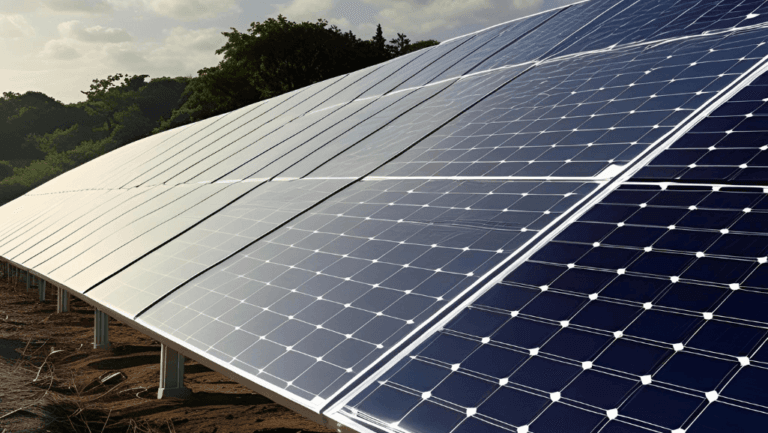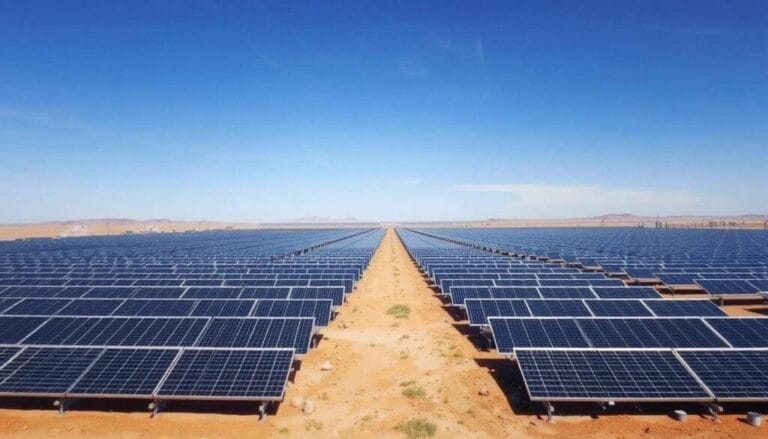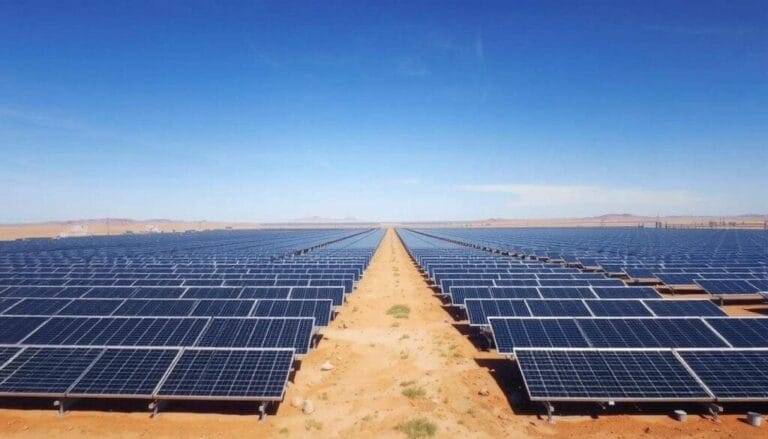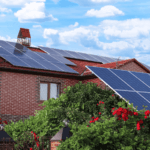Ready to harness the power of the sun and save money? Solar incentives are making it easier than ever for homeowners to switch to clean, renewable energy. These financial perks, including solar tax credits and rebates, can significantly reduce the cost of installing a solar panel system for your home.
The benefits of solar energy extend beyond just lower electricity bills. With solar incentives, you’re not only investing in a sustainable future but also boosting your home’s value. From federal tax credits to state-specific programs, there’s a wide array of renewable energy incentives available to help you make the switch.
In 2022, the federal solar tax credit was increased to 30% for installations through 2032. This means you can claim nearly a third of your solar system’s cost on your taxes. Plus, many states offer additional perks like property tax exemptions and performance-based incentives, making solar even more affordable.
Key Takeaways
- Federal solar tax credit offers 30% savings on installation costs
- State-specific incentives can further reduce solar expenses
- No maximum limit on federal tax credit claims
- Eligible expenses include panels, labor, and energy storage devices
- Property and sales tax exemptions available in many states
- Net metering programs provide additional savings opportunities
- Grants and low-interest loans make solar more accessible
Understanding Solar Incentives
Solar incentives are powerful tools to make clean energy more accessible. These programs offer financial benefits to homeowners and businesses who invest in solar power systems. Let’s explore the various types of solar panel incentives, their benefits, and eligibility criteria.
Types of Solar Incentives
Solar financing options come in different forms:
- Tax credits: Reduce your tax liability dollar-for-dollar
- Rebates: Provide cash back for purchasing and installing solar systems
- Performance-based incentives: Offer payments for solar energy production
The federal residential solar tax credit is a prime example, offering a 30% tax credit on solar system costs until 2033. This incentive has helped the U.S. solar industry grow by over 200% in the past two decades, according to the Solar Energy Industries Association.
Benefits of Solar Incentives
Solar rebates and incentives offer numerous advantages:
- Reduced upfront costs
- Lower tax burdens
- Ongoing savings on energy bills
- Increased property value
On average, homeowners save an additional $9,716 on solar costs when claiming the federal tax credit. Some states offer extra incentives, further increasing savings.
Eligibility Criteria
Eligibility for solar incentives varies depending on the program. For the federal solar tax credit:
- All income brackets are eligible
- The solar system must be installed between 2017 and 2034
- Both homeowners and businesses can qualify
State-level incentives have their own requirements. It’s crucial to check local rules before deciding on a solar installation.
| Incentive Type | Benefit | Duration |
|---|---|---|
| Federal Tax Credit | 30% of system cost | Until 2033 |
| State Tax Credits | Varies by state | Ongoing |
| Utility Rebates | Cash back on installation | Limited time offers |
Federal Solar Investment Tax Credit (ITC)
The Federal Solar Investment Tax Credit (ITC) is a game-changer for homeowners considering solar energy. This powerful federal solar incentive allows you to claim 30% of your total solar PV system cost as a tax credit. The ITC has been a driving force behind the 200-fold growth of the U.S. solar industry since its inception in 2006.
Under the current ITC structure, homeowners can enjoy significant savings:
- 30% tax credit for systems installed between 2022 and 2032
- 26% credit in 2033
- 22% credit in 2034
- Phaseout in 2035 unless renewed
The beauty of solar tax credits lies in their flexibility. There’s no maximum dollar amount, and unused credits can roll over for up to five years. This makes the ITC accessible to a wide range of homeowners, regardless of their tax situation.
Let’s break down the numbers. With the average solar panel system costing between $15,000 and $20,000, the 30% ITC can slash your expenses by $4,500 to $6,000. That’s a substantial saving that can make solar energy more attainable for many households.
The ITC doesn’t just cover panels. Eligible expenses include additional equipment, batteries, labor costs, and even sales tax on qualifying items. This comprehensive coverage makes investing in clean energy more appealing than ever.
Remember, to qualify for these federal solar incentives, your system must be new, located in the U.S., owned by you, and placed in a qualifying residence. With the ITC set to decrease in the coming years, now is the perfect time to harness the power of the sun and enjoy substantial savings on your energy bills.
State-Specific Solar Tax Credits
State solar incentives play a crucial role in making solar energy more accessible to homeowners. Many states offer unique tax credits to complement federal programs, providing substantial savings for those investing in solar power systems.
Examples of State Solar Tax Credits
New York stands out with its generous state solar incentives. The NY-Sun Megawatt Block Program offers cash incentives of $0.20 to $0.30 per watt for residential solar installations. Additionally, New York provides a 25% state tax credit, up to $5,000, for home solar systems. These solar energy subsidies can significantly reduce the overall cost of going solar.
How to Claim State Tax Credits
Claiming state tax credits for solar installations typically involves filing specific forms with your state tax return. In New York, homeowners can combine the state’s 25% tax credit with the federal 30% Investment Tax Credit, maximizing their savings. It’s essential to keep detailed records of your solar installation costs and consult with a tax professional to ensure proper filing.
Combining Federal and State Credits
The synergy between federal and state green energy incentives can lead to substantial cost reductions. For a 6-kW home solar system in New York, initially priced at $19,800, the combination of NY-Sun rebates and tax credits can bring the net cost down to about $8,370. This dramatic reduction results in a payback period of just four to five years, making solar an attractive investment for many homeowners.
| Incentive Type | Amount | Availability |
|---|---|---|
| NY-Sun Cash Incentive | $0.20-$0.30 per watt | One-time, at purchase |
| NY State Tax Credit | 25% up to $5,000 | Annual tax filing |
| Federal ITC | 30% of system cost | Annual tax filing |
Performance-Based Incentives (PBIs)
Performance-Based Incentives (PBIs) are game-changers in the world of solar power incentives. These rewards pay homeowners for their solar energy production sent to the electric grid over time. PBIs are typically structured as fixed payments per kilowatt-hour (kWh) of electricity produced or as a percentage of the customer’s bill offset by solar output.
Feed-in tariffs (FITs) are a popular type of PBI offered in some states. They guarantee payments higher than the grid’s market price for electricity, usually over 15-20 year contracts. This long-term commitment provides stability and encourages solar energy production.
PBIs are usually paid out quarterly for six years following a successful system inspection. For example, a utility offering a $0.10/kWh PBI for a 5-kW system generating 100 kWh could result in a $30 quarterly incentive. This ongoing reward can significantly offset the initial installation costs, which average $31,460 before incentives in 2024.
One key advantage of PBIs is their accuracy in representing the value of solar energy to the grid and society. Unlike other incentives, PBIs don’t require market transactions and can be paid directly by the utility to the customer. This flexibility allows for diverse incentive structures that benefit both homeowners and the broader community.
PBIs can be combined with other solar power incentives like the Federal Investment Tax Credit (ITC) and Solar Renewable Energy Certificates (SRECs) to maximize financial returns. By boosting demand for solar systems, PBIs also create jobs in the solar industry, from manufacturing to installation.
Solar Renewable Energy Certificates (SRECs)
Solar Renewable Energy Certificates (SRECs) offer a unique way for solar panel owners to earn extra income. These certificates represent the green energy produced by solar systems, with one SREC typically earned for every 1,000 kilowatt-hours (1 MWh) of electricity generated.
How SRECs Work
SRECs are part of a system designed to encourage renewable energy production. Utility companies buy these solar energy certificates to meet state-mandated renewable energy goals. For solar panel owners, this means an additional revenue stream on top of electricity savings.
SREC Markets and Values
SREC markets exist in less than 10 U.S. states, each with its own pricing structure. Values can vary significantly:
| State | Average SREC Price | Estimated Annual Earnings |
|---|---|---|
| Washington D.C. | $405 | $4,050 – $5,265 |
| Maryland | $60 | $600 – $780 |
| Pennsylvania | $48 | $480 – $624 |
| Virginia | $50 | $500 – $650 |
| Ohio | $5 | $50 – $65 |
Earning Revenue from SRECs
Homeowners can sell their renewable energy credits through various methods. Options include upfront lump sum sales, fixed-term contracts ranging from 3 to 15 years, or selling on the spot market. While spot market sales can maximize earnings, they come with the risk of price fluctuations. Sustainable energy advocates often recommend a balanced approach to SREC sales, considering both immediate needs and long-term market trends.
Remember, SRECs must be sold within three years of production on the spot market. The PJM Generation Attribute Tracking System (GATS) is crucial for registering and tracking SREC generation in many states.
Utility Company Rebates for Solar Energy
Utility companies offer enticing rebates to promote solar panel installation. These utility rebates serve as upfront solar installation incentives, providing homeowners with immediate financial benefits. Cash-back programs vary by location and energy provider, making it crucial to research local options.
In New York, the NY-Sun program leads the charge with attractive incentives. It reduces the cost of purchasing and installing solar systems for residents. The program works directly with selected contractors to deliver these benefits. For income-qualified households, Affordable Solar provides extra incentives, coupled with minor energy efficiency upgrades.
The Megawatt Block Incentive in New York stands out among utility rebates. It offers $0.30 per watt of installed solar capacity. For instance, an 8 kW system could receive a substantial $2,400 refund. This incentive significantly lowers the initial investment for homeowners considering solar energy.
- Federal Solar Tax Credit: 30% of system cost until 2033
- NY State Solar Equipment Tax Credit: 25% with $5,000 cap
- Sales tax exemption: 4% on solar panel purchase
- Property tax exemption: 15 years on solar energy systems
To claim these rebates, homeowners typically need to submit an application and provide documentation of their solar installation. It’s worth noting that availability and amounts can differ significantly between utility companies and locations. Always check with local providers for the most up-to-date information on solar installation incentives in your area.
Property and Sales Tax Exemptions
Solar tax exemptions offer significant financial benefits for homeowners considering solar panel installation. These incentives make solar energy more accessible and affordable, encouraging widespread adoption of clean energy solutions.
Property Tax Exemptions Explained
Property tax incentives prevent homeowners from paying extra taxes on the increased value of their property after installing solar panels. In New Jersey, for example, there’s a 100% property tax exemption on the added value from renewable energy systems. This means you can upgrade your home with solar without worrying about higher property taxes.
Sales Tax Exemptions for Solar Equipment
Sales tax benefits apply to the purchase of solar energy equipment. New Jersey offers a 100% state sales tax exemption on solar systems, saving homeowners 7% on their purchase. This exemption typically covers panels, inverters, and mounting racks, making the initial investment more affordable.
States Offering Tax Exemptions
Many states across the U.S. provide tax exemptions to promote solar adoption. Here’s a snapshot of some states offering these incentives:
| State | Property Tax Exemption | Sales Tax Exemption |
|---|---|---|
| New Jersey | 100% | 100% |
| California | 100% | Partial |
| Massachusetts | 100% | 100% |
| New York | 15-year exemption | 100% |
These solar tax exemptions, combined with other incentives like the federal Solar Investment Tax Credit, can lead to substantial savings over the lifespan of your solar panel system.
Net Metering Programs
Net metering is a game-changer for solar energy users. This program allows homeowners to earn solar energy credits for excess power their panels generate. When your system produces more electricity than you need, it’s sent back to the grid. Your meter spins backward, giving you credit for future use.
The grid connection benefits are substantial. You can use these credits when your panels aren’t producing enough, like at night or on cloudy days. This system helps balance your energy consumption and production over time.
In Virginia, Dominion Energy leads the charge with the top utility net metering program. They’re incentivizing renewable energy adoption, making solar more attractive for homeowners. The state has two interconnection standards: one for net-metered systems and another for non-net metered ones.
Let’s break down the economic value of net metering in Virginia:
| Energy Generated | Electricity Savings | SREC Income | Total Value |
|---|---|---|---|
| 1,000 kWh | $144 | $50 – $70 | $194 – $214 |
With net metering, your solar investment pays off faster. A well-sized system in Virginia can reach payback in less than seven years. This quick return is thanks to the 30% federal tax credit and the state’s Solar Renewable Energy Certificate (SREC) program.
Solar Incentives for Specific Situations
Solar incentives aren’t one-size-fits-all. They cater to various scenarios, making solar power accessible to more people. Whether you’re considering solar for your main home, vacation property, or off-grid system, there’s likely an incentive for you.
Primary residences benefit from the most comprehensive residential solar incentives. These often include federal tax credits, state rebates, and local utility programs. For example, in Texas, homeowners can save over $1,350 yearly on electric bills with a typical 6 kW system.
Second homes aren’t left out. The federal tax credit applies to vacation properties too. This 30% credit can significantly reduce the cost of your solar installation, even on a property you don’t live in year-round.
Off-grid solar systems also qualify for incentives. As long as they generate electricity for residential use, these systems are eligible for the federal tax credit. This is great news for those in remote areas or seeking energy independence.
Mixed-use properties, like homes with office spaces, can claim the full residential credit if at least 80% of the system serves residential purposes. This flexibility helps small business owners and remote workers maximize their solar benefits.
| Property Type | Federal Tax Credit | State Incentives | Local Rebates |
|---|---|---|---|
| Primary Residence | 30% | Varies by state | Often available |
| Second Home | 30% | Limited | Rare |
| Off-Grid System | 30% | Varies | Limited |
| Mixed-Use Property | 30% (if 80%+ residential) | Varies | Possible |
Even financed systems can benefit. If you’re contractually obligated to pay the full cost, you can claim the entire tax credit. This opens doors for those who can’t pay upfront but want to enjoy solar’s long-term savings.
Commercial properties aren’t left out either. Businesses can enjoy substantial commercial solar benefits, including accelerated depreciation and potential state-specific incentives. This makes solar an attractive investment for companies looking to reduce operating costs and boost sustainability.
Grants and Low-Cost Loans for Solar Installation
Homeowners looking to harness solar power can tap into various financial assistance programs. These options make solar energy more accessible and affordable for many households.
Government Agencies Offering Financial Assistance
Several federal agencies provide solar energy grants and low-interest solar loans. The Weatherization Assistance Program (WAP) helps low-income families reduce energy costs, potentially including solar installations. The Rural Energy for America Program offers grants covering up to 50% of project costs for agricultural producers and rural small businesses.
Applying for Solar Grants and Loans
To apply for these financial assistance programs, review guidelines carefully and submit accurate applications. The Solar Savings-to-Investment tool can help calculate your system’s cost-effectiveness. Remember, renewable energy system grants range from $2,500 to $1 million, while energy efficiency grants span from $1,500 to $500,000.
Eligibility Requirements
Eligibility varies by program. For instance, the Low Income Home Energy Assistance Program (LIHEAP) targets families needing help with energy costs. The Rural Energy Savings Program facilitates affordable loans for energy-saving measures in rural areas. Generally, applicants must contribute at least 25% of the project cost when applying for loans. Check with local offices, as applications are often accepted year-round.


























